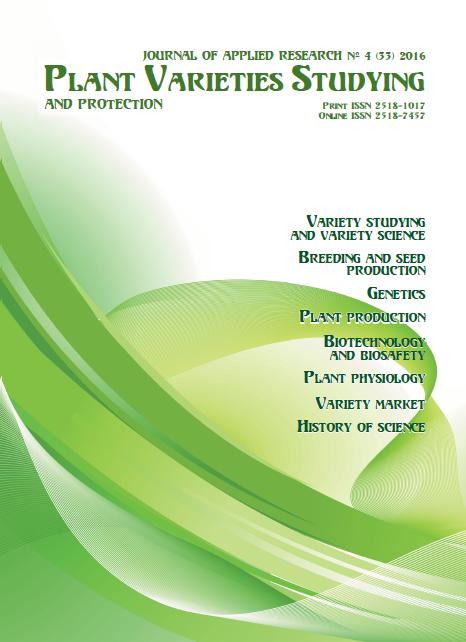Evaluation of pea varieties based on correlation of quantitative traits and indices
DOI:
https://doi.org/10.21498/2518-1017.4(33).2016.88674Keywords:
pea, variety, quantitative trait, productivity elements, index, correlationAbstract
Purpose. To evaluate pea plants productivity and determine the degree of correlation among the main agronomic characters in pea varieties.
Methods. Structural and statistical analysis.
Results. Evaluation of pea samples in terms of indices of plant productivity elements level based on correlation analysis and single-factor indices appliance provided insight into the ratio of one trait share per unit of another one. It was defined that some correlations among the elements of productivity was not only moderate and weak, but they also changed their sign that could be the evidence of growth conditions influence on structural relationships between some traits and, consequently, redistribution of their contributions to the formation of variety productivity. Positive and very close relationship of many traits was revealed, particularly between plant height and the height of the plant up to the first bean, the number of nodes and the number of sterile nodes (r = 0,95–0,97). Methodological aspects of the variety model creation were considered, that may be useful not only in pea breeding but also for improving the technology of its cultivation.
Conclusions. Correlation relationships were established between the number of beans and the number of fruiting nodes and the number of carpophores containing 2 beans (r = 0,86–0,88), seed mass and plant mass (r = 0,81), the number of seeds per plant and plant mass and seed mass per plant (r = 0,78–0,81), the number of certified seeds and the number of seeds per plant (r = 0,84), the average number of beans per fertile node and the number of carpophores containing 2 beans (r = 0,74) that makes it possible to use them in assessing the productivity of plants.
Downloads
References
Ivaniuk, S. V., & Hliavin, A. V. (2012). Evaluation of common bean samples based on correlation of quantitative traits and indices. Selektsia I Nasinnitstvo [Plant Breeding and Seed Production], 101, 192–197. [in Ukrainian]
Zhuchenko, A. A. (1988). Adaptivnyy potentsial kul’turnykh rasteniy: Ekologo-geneticheskie osnovy [Adaptive potential of cultivated plants: Ecological and genetic basic principles]. Kishinev: Shtiintsa. [in Russian]
Kokhaniuk, N. V. (2014). Evaluation of soybean varieties based on correlation of quantitative traits and indices. Selektsia I Nasinnitstvo [Plant Breeding and Seed Production], 106, 74–76. [in Ukrainian]
Marchenko, T. Yu. (2012). Correlation relationships of quantitative traits of irrigated soybean samples. Zroshuvane zemlerobstvo [Irrigated Agriculture], 57, 238–242. [in Ukrainian]
Mykhailov, V. H., Slisarchuk, M. V., Shcherbyna, O. Z., & Romaniuk, L. S. (2008). Correlation relationship between major economic traits in soybean forms with a fascinated and unfascinated type of the stem. Henetychni resursy roslyn [Plant Genetic Resources], 6, 49–55. [in Ukrainian]
Ivaniuk, S. V., & Temchenko, I. V. (2011). Mathematical and statistical methods for evaluating soybean source material for productivity elements. Kormy i kormovyrobnytstvo [Feeds and Feed Production], 69, 45–53. [in Ukrainian]
Dragavtsev, V. A. (1995). Ecological and genetic model of the organization of plant quantitative traits. Sel’skokhozyaistvennaya biologiya [Agricultural Biology], 5, 20–29. [in Russian]
Drozdov, V. I. (2010). Instruktsiya po ispolzovaniyu paketa Statistica 6.0 [Manual for using the Statistica 6.0]. Kursk: Izdatelstvo YuZGU. [in Russian]
Marques de Sá, J. P. (2007). Applied Statistics Using SPSS, STATISTICA, MATLAB and R. (2nd ed.). Berlin: Springer-Verlag Berlin Heidelberg. doi: 10.1007/978-3-540-71972-4
Ermantraut, E. R., Prysiazhniuk, O. I., & Shevchenko, I. L. (2007). Statystychnyi analiz ahronomichnykh doslidnykh danykh v paketi STATISTICA 6.0 [Statistical analysis of agronomic study data in the Statistica 6.0 software suite]. Kyiv: PolihrafKonsaltynh. [in Ukrainian]
Downloads
Published
How to Cite
Issue
Section
License
Copyright (c) 2016 Ukrainian Institute for Plant Variety Examination

This work is licensed under a Creative Commons Attribution-ShareAlike 4.0 International License.
Starting in 2022, the copyright to the publication remains with the authors
Our journal abides by the CREATIVE COMMONS copyright rights and permissions for open access journals.
Authors, who are published in this journal, agree to the following conditions:
- The authors reserve the right to authorship of the work and pass the first publication right of this work to the journal under the terms of a Creative Commons Attribution License, which allows others to freely distribute the published research with the obligatory reference to the authors of the original work and the first publication of the work in this journal.
- The authors have the right to conclude separate supplement agreements that relate to non-exclusive work distribution in the form in which it has been published by the journal (for example, to upload the work to the online storage of the journal or publish it as part of a monograph), provided that the reference to the first publication of the work in this journal is included.

























 Ukrainian Institute for Plant Varieties Examination
Ukrainian Institute for Plant Varieties Examination  Селекційно-генетичний інститут
Селекційно-генетичний інститут Institute of Plant Physiology and Genetics of the National Academy of Sciences of Ukraine
Institute of Plant Physiology and Genetics of the National Academy of Sciences of Ukraine
 The National Academy of Agrarian Sciences of Ukraine
The National Academy of Agrarian Sciences of Ukraine